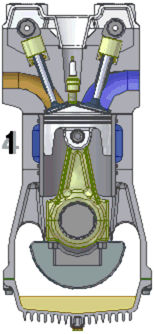
Image via Wikipedia
With my son, I did some tests to determine if we had the three elements of internal combustion: fuel, spark and compression. We had all three of these, so we turned to see which of the cylinders wasn't working properly. Pulling the ignition wires one at a time told us which cylinder wasn't firing, so we swapped the spark plugs to see if it was the plugs. The same cylinder wouldn't fire, and when the engine ran, it was backfiring.
I pulled the cowling and found that our friendly mice had packed fiberglass insulation around the cylinder head on that side, which probably caused the cylinder to overheat and seize. I took off the valve cover, and voila! There were the bent valve push rods. I removed them, straightened them, and put them back in the motor. I buttoned it all up again and it turned over like it was new.
The important question is: why did the push rods get bent? I believe that the mice and their insulation caused the cylinder head to overheat, and the cylinder must have seized there when we shut it off last. When the cylinder seizes at the top of the stroke, the valves will crash into it and the push rods will bend. My expectation is that the cast iron parts are much stronger than the push rods, so they failed as designed, protecting the innards of the cylinder.
I feel it is a good idea to put new push rods in there, so I got the part numbers from the manual and headed on over to Sears. Turns out that they closed their parts depot, and no longer carry parts. Customers must use the online parts service to get replacement parts. I tried to get them at a couple of local small engine shops, but they don't have the cross references to the Sears parts, even though it's a Briggs & Stratton engine.
So, I'm now at the mercy of Sears. It is sad that the once mighty and convenient Sears has been reduced to an online parts counter. I know where I won't spend my money when the time comes for my next tractor.


Leave a comment